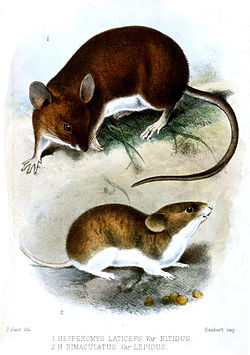| Euryoryzomys | |
|---|---|
 | |
| Euryoryzomys nitidus (top) and Calomys laucha (bottom) | |
| Scientific classification | |
| Domain: | Eukaryota |
| Kingdom: | Animalia |
| Phylum: | Chordata |
| Class: | Mammalia |
| Order: | Rodentia |
| Family: | Cricetidae |
| Subfamily: | Sigmodontinae |
| Tribe: | Oryzomyini |
| Genus: | Euryoryzomys Weksler et al., 2006 |
| Type species | |
| Oryzomys macconnelli Thomas, 1910 | |
Euryoryzomys is a genus of rodents in the tribe Oryzomyini of family Cricetidae. [1] It includes seven species, which are distributed in South America. [1] [2] Until 2006, its members were included in the genus Oryzomys , but they are not closely related to the type species of that genus, and therefore they were placed in a new genus. [1] They are most closely related to genera like Hylaeamys and Transandinomys ; many members of these genera were previously placed in a single species, known as Oryzomys capito. [1] The genus name, Euryoryzomys, combines the name "Oryzomys" with the Ancient Greek word eurus "broad", referring to the broad range in distribution of the genus. [1]
It includes the following species:
- Euryoryzomys emmonsae (Musser, Carleton, Brothers & Gardner, 1998)
- Euryoryzomys lamia (Thomas, 1901)
- Euryoryzomys legatus (Thomas, 1925)
- Euryoryzomys macconnelli (Thomas, 1910)
- Euryoryzomys nitidus (Thomas, 1884)
- Euryoryzomys russatus (Wagner, 1848)
- Euryoryzomys cerqueirai Percequillo & Weksler, 2023 [2] : 607







